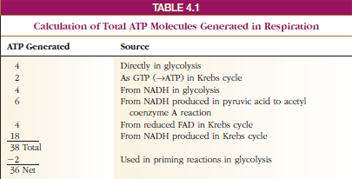Efficiency of Oxidative Phosphorylation
Efficiency of Oxidative
Phosphorylation
We are now in a position to calculate the ATP yield from the complete oxidation of glucose (Figure 4-15). The overall reaction is:

ATP has been generated at several
points along the way (Table 4-1). The
cytoplasmic NADH generated in glycolysis
requires a molecule of ATP to
fuel transport of each molecule of
NADH into a mitochondrion; therefore
each NADH from glycolysis results in
only two ATP (total of four), compared
with the three ATP per NADH (total
of six) formed within mitochondria.
Accounting for the two ATP used in
the priming reactions in glycolysis, the
net yield may be as high as 36 molecules
of ATP per molecule of glucose.
(The yield of 36 ATP is a theoretical
maximum because some of the H+ gradient produced by electron transport
may be used for other functions,
such as transporting substances in and
out of the mitochondrion.) Overall efficiency
of aerobic oxidation of glucose
is about 38%, comparing very favorably
with human-designed energy conversion
systems, which seldom exceed
5% to 10% efficiency.
We are now in a position to calculate the ATP yield from the complete oxidation of glucose (Figure 4-15). The overall reaction is:
 |
 |
| Figure 4-15 Pathway for oxidation of glucose and other carbohydrates. Glucose is degraded to pyruvic acid by cytoplasmic enzymes (glycolytic pathway). Acetyl coenzyme A is formed from pyruvic acid and is fed into the Krebs cycle. An acetyl group (two carbons) is oxidized to two molecules of carbon dioxide with each turn of the cycle. Pairs of electrons are removed from the carbon skeleton of the substrate at several points in the pathway and are carried by oxidizing agents NADH or FADH2 to the electron transport chain where 32 molecules of ATP are generated. Four molecules of ATP are also generated by substrate phosphorylation in the glycolytic pathway, and two molecules of ATP (initially GTP) are formed in the Krebs cycle. This yields a total of 38 molecules of ATP (36 molecules net) per glucose molecule. Molecular oxygen is involved only at the very end of the pathway. |




